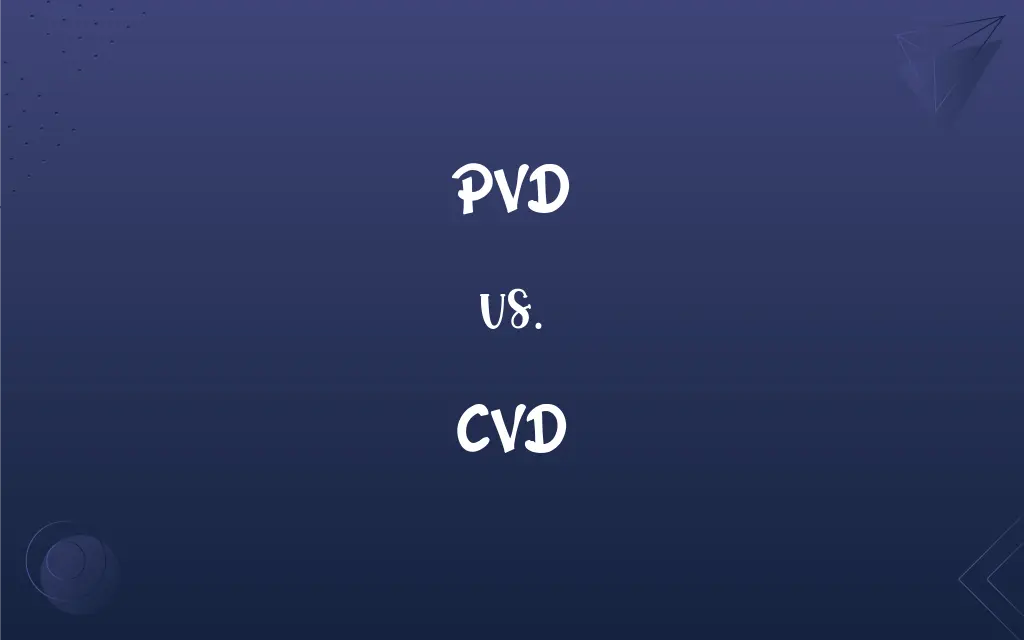PVD vs. CVD: What's the Difference?
Edited by Aimie Carlson || By Janet White || Published on February 24, 2024
PVD (Peripheral Vascular Disease) affects blood vessels outside the heart and brain, often in legs, while CVD (Cardiovascular Disease) involves the heart and blood vessels, including coronary artery disease and heart attacks.

Key Differences
PVD primarily affects the peripheral blood vessels, particularly in the legs, leading to reduced blood flow and associated symptoms. CVD encompasses a range of conditions affecting the heart and blood vessels, including coronary artery disease, heart attacks, and stroke.
Symptoms of PVD include leg pain, numbness, and poor wound healing in the extremities. CVD symptoms are broader, including chest pain, shortness of breath, and heart palpitations.
Both PVD and CVD share common risk factors like smoking, diabetes, and hypertension, but the specific impacts on the body differ.
Treatment of PVD often involves lifestyle changes and medications to improve blood flow to the limbs. CVD treatment can range from lifestyle changes to medications, surgeries, and interventions like stenting or bypass surgery.
Preventing PVD and CVD involves managing risk factors like high blood pressure, cholesterol, and maintaining a healthy lifestyle. Regular exercise and diet play a crucial role in both.
ADVERTISEMENT
Comparison Chart
Affected Areas
Peripheral vessels, mainly in legs
Heart and blood vessels throughout the body
Common Symptoms
Leg pain, numbness, poor wound healing
Chest pain, shortness of breath, palpitations
Typical Onset
Gradual, with age and lifestyle factors
Can be sudden or gradual
Treatment Options
Lifestyle changes, medications
Medications, surgeries, lifestyle changes
Diagnostic Tests
Ankle-brachial index, ultrasound
ECG, angiography, stress tests
ADVERTISEMENT
PVD and CVD Definitions
PVD
Involves narrowed or blocked blood vessels outside the heart.
Smoking is a significant risk factor for PVD.
CVD
Includes conditions like heart attacks and stroke.
Emergency treatment is crucial for acute CVD events.
PVD
A circulatory disorder reducing blood flow to limbs.
PVD can lead to slow wound healing in the legs.
CVD
Encompasses diseases of the heart and blood vessels.
High cholesterol is a major risk factor for CVD.
PVD
Managed through lifestyle changes and medication.
Early detection of PVD is crucial for effective management.
CVD
Risk factors include smoking, diabetes, and obesity.
Lifestyle changes can significantly reduce CVD risks.
PVD
A condition affecting blood flow in peripheral vessels.
He was diagnosed with PVD after experiencing leg cramps.
CVD
Managed through a combination of treatments.
Medications play a key role in CVD management.
PVD
Often manifests as claudication or pain during walking.
Her PVD symptoms improved with regular exercise.
CVD
Often related to atherosclerosis or plaque buildup.
Regular check-ups are important for CVD prevention.
FAQs
Can CVD be prevented?
While not all types can be prevented, many CVD risks can be reduced with lifestyle changes and medical interventions.
What distinguishes PVD from CVD?
PVD affects peripheral vessels, mainly in the legs, while CVD involves heart and blood vessels, including arteries and veins.
Are PVD and CVD symptoms similar?
PVD symptoms are more localized to the limbs, while CVD symptoms involve chest pain, breathlessness, and heart-related signs.
How is CVD diagnosed?
Through a combination of physical examination, imaging tests, and blood tests.
Is leg pain always a sign of PVD?
Not always, but it's a common symptom, especially when it occurs during walking or exercise.
Is PVD curable?
PVD can be managed effectively with treatment, but not completely cured.
Can smoking cessation improve PVD and CVD?
Yes, quitting smoking is one of the most effective ways to reduce the risk and progression of both conditions.
Can diet influence PVD and CVD?
A healthy diet is crucial in managing and preventing both PVD and CVD.
Can PVD lead to heart problems?
While PVD itself doesn't cause heart problems, shared risk factors can also contribute to CVD.
Does diabetes increase the risk of PVD and CVD?
Yes, diabetes is a significant risk factor for both PVD and CVD.
Are PVD and CVD genetic?
Genetics play a role, but lifestyle factors are also significant contributors.
Can exercise reduce the risk of PVD?
Yes, regular exercise improves circulation and can help manage PVD.
Are there medications for PVD?
Yes, medications can help improve blood flow and manage symptoms.
Is PVD common in older adults?
Yes, PVD prevalence increases with age.
Are there surgeries to treat PVD?
In severe cases, surgical interventions may be needed.
Is high blood pressure a common factor in CVD?
Yes, hypertension is a major risk factor for CVD.
Can stress affect PVD and CVD?
Yes, stress can exacerbate both conditions.
Can obesity lead to CVD?
Yes, obesity is a significant risk factor for CVD.
Is CVD more common in men or women?
CVD is common in both, but some types may affect one gender more than the other.
What's the main cause of CVD?
It's often due to atherosclerosis, but various factors contribute.
About Author
Written by
Janet WhiteJanet White has been an esteemed writer and blogger for Difference Wiki. Holding a Master's degree in Science and Medical Journalism from the prestigious Boston University, she has consistently demonstrated her expertise and passion for her field. When she's not immersed in her work, Janet relishes her time exercising, delving into a good book, and cherishing moments with friends and family.
Edited by
Aimie CarlsonAimie Carlson, holding a master's degree in English literature, is a fervent English language enthusiast. She lends her writing talents to Difference Wiki, a prominent website that specializes in comparisons, offering readers insightful analyses that both captivate and inform.































































